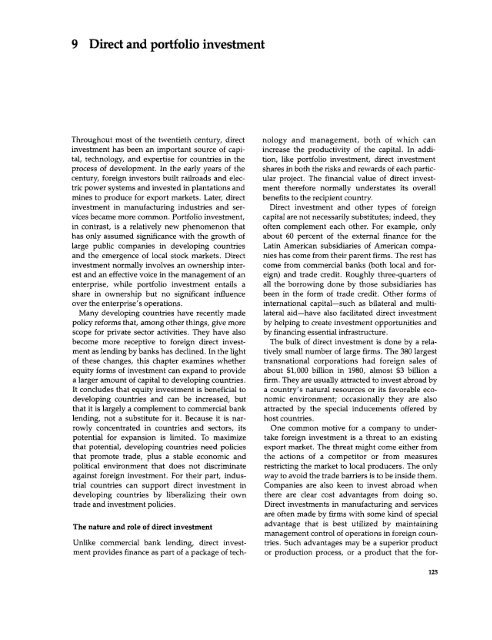World Bank Document
World Bank Document
World Bank Document
You also want an ePaper? Increase the reach of your titles
YUMPU automatically turns print PDFs into web optimized ePapers that Google loves.
9 Direct and portfolio investment<br />
Throughout most of the twentieth century, direct nology and management, both of which can<br />
investment has been an important source of capi- increase the productivity of the capital. In addital,<br />
technology, and expertise for countries in the tion, like portfolio investment, direct investment<br />
process of development. In the early years of the shares in both the risks and rewards of each particcentury,<br />
foreign investors built railroads and elec- ular project. The financial value of direct investtric<br />
power systems and invested in plantations and ment therefore normally understates its overall<br />
mines to produce for export markets. Later, direct benefits to the recipient country.<br />
investment in manufacturing industries and ser- Direct investment and other types of foreign<br />
vices became more common. Portfolio investment, capital are not necessarily substitutes; indeed, they<br />
in contrast, is a relatively new phenomenon that often complement each other. For example, only<br />
has only assumed significance with the growth of about 60 percent of the external finance for the<br />
large public companies in developing countries Latin American subsidiaries of American compaand<br />
the emergence of local stock markets. Direct nies has come from their parent firms. The rest has<br />
investment normally involves an ownership inter- come from commercial banks (both local and forest<br />
and an effective voice in the management of an eign) and trade credit. Roughly three-quarters of<br />
enterprise, while portfolio investment entails a all the borrowing done by those subsidiaries has<br />
share in ownership but no significant influence been in the form of trade credit. Other forms of<br />
over the enterprise's operations. international capital-such as bilateral and multi-<br />
Many developing countries have recently made lateral aid-have also facilitated direct investment<br />
policy reforms that, among other things, give more by helping to create investment opportunities and<br />
scope for private sector activities. They have also by financing essential infrastructure.<br />
become more receptive to foreign direct invest- The bulk of direct investment is done by a relament<br />
as lending by banks has declined. In the light tively small number of large firms. The 380 largest<br />
of these changes, this chapter examines whether transnational corporations had foreign sales of<br />
equity forms of investment can expand to provide about $1,000 billion in 1980, almost $3 billion a<br />
a larger amount of capital to developing countries. firm. They are usually attracted to invest abroad by<br />
It concludes that equity investment is beneficial to a country's natural resources or its favorable ecodeveloping<br />
countries and can be increased, but nomic environment; occasionally they are also<br />
that it is largely a complement to commercial bank attracted by the special inducements offered by<br />
lending, not a substitute for it. Because it is nar- host countries.<br />
rowly concentrated in countries and sectors, its One common motive for a company to underpotential<br />
for expansion is limited. To maximize take foreign investment is a threat to an existing<br />
that potential, developing countries need policies export market. The threat might come either from<br />
that promote trade, plus a stable economic and the actions of a competitor or from measures<br />
political environment that does not discriminate restricting the market to local producers. The only<br />
against foreign investment. For their part, indus- way to avoid the trade barriers is to be inside them.<br />
trial countries can support direct investment in Companies are also keen to invest abroad when<br />
developing countries by liberalizing their own there are clear cost advantages from doing so.<br />
trade and investment policies.<br />
Direct investments in manufacturing and services<br />
are often made by firms with some kind of special<br />
The nature and role of direct investment advantage that is best utilized by maintaining<br />
management control of operations in foreign coun-<br />
Unlike commercial bank lending, direct invest- tries. Such advantages may be a superior product<br />
ment provides finance as part of a package of tech- or production process, or a product that the for-<br />
125

















